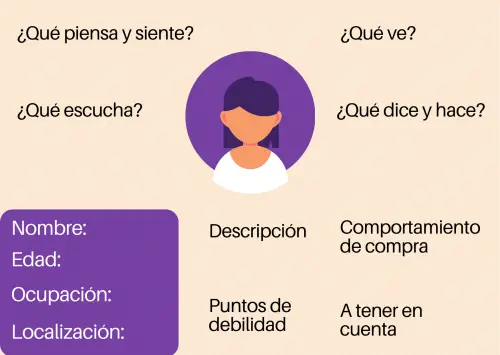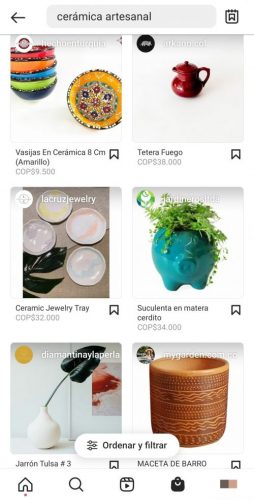Translated by Nick R
Have you ever tried selling your ceramic pieces online, but panicked because you don’t know what the key to success is? Don’t worry about it anymore, we will teach you in a very simple way how you can sell your crafts online without failing in the attempt!
Table of Contents
Selling on the Internet?
You are making the right decision by selling your pieces online, we are telling you. Many markets and industries have moved towards online marketing, and handicrafts are no exception, so you will be giving a crucial step for your workshop.
However, we understand that making a living from crafts or art is not easy, and having a physical store can be complicated and costly. That’s why moving into the digital market is such a great idea for potters like you, who are looking for the public to appreciate and support their art by purchasing or brand recognition.
For you to achieve all this we will tell you what aspects you should consider making your online shopping a success. Also, some websites and social networks that can work for your workshop, each with their pros and cons, so you can choose the best option for you.

What should you take into account to sell ceramics over the Internet successfully?
There are certain key aspects when it comes to selling pottery online. We will tell you in detail, so you can create a community with people who love your brand and thus sell a lot.
Photographs of your pieces
The first thing we will cover is how to photograph your art pieces. It is paramount since they are the presentation of the product; people will look at them before anything so they must be well shot to capture people’s attention and sell the product.
- You need to set up a nice spot to photograph your pieces. For instance, you could make an infinite background with a large white piece of paper so that all the attention is centered on your pottery, or set it up within the environment for which it is intended: tableware on a table, for example.
- Combine colors nicely to achieve harmony and a great look. This applies in case you are placing your piece somewhere other than the infinite background. Pay close attention to the colors of the ceramic, the table, the wall and the complementary objects, etc. If you are not very skilled at combining colors, you can use the chromatic circle.
- Adjust the light so that your piece looks good, neither too bright nor too dark. If using the infinite background, you can do that by placing a light ring or a light box above the piece. If not, you will need to add more lights or play with the sunlight.
- However, you may have created a great setting, with everything matching and perfect lighting, but if you don’t have a good camera, it will be difficult to get customers to see what you’re actually seeing. You don’t need a professional camera, you can use your cell phone camera or a friend’s camera, as long as it gives good pictures.
Good cameras must have a high resolution, which is close to the number of megapixels they have; the more the better the resolution. Also, it must have a good aperture that is how much light it can capture; an optical stabilizer to help keep the image steady, even if you move; and good software.
- Do careful editing of your photos. It is always best if you edit the photos instead of leaving them untouched. Sure they need some brightness, contrast or saturation adjustment. If you don’t know much about this, this basic editing guide can help you a lot.

The target audience
In case you are not aware, there is a specific kind of person with special tastes for every market, namely, the target, as it is called in the marketing world. The ceramic industry is not out of this, thus for each piece you offer, there will be a group of people willing to buy it.
Someone who likes ceramics is not necessarily going to like all pieces. Either rustic, modern, certain colors, decorative or functional, there are too many options, and that is something to keep in mind.
- You have to identify what kind of pieces you make, what their added value and function is, and what types of people like pieces like yours. Once you have identified your audience, you will know how to carry out the next two aspects.
- Depending on your workshop’s target, you have to create a visual identity for your brand and, in turn, the look and feeling of your web page. The visual identity basically consists of the colors, the shapes, the arrangement of things and the typography to be used always.
- Even more, you need a sort of language to communicate with your audience; a way of addressing them. For example, for a young audience, you can be close and fun, whereas, for an adult and sophisticated public, you could go for an elegant and serious style.
This will also apply to the copy of your publications, i.e., the text that accompanies the images.

Be very patient
When having direct contact with customers, you will have to play the friendly and cooperative role of someone who works in customer service. Then patience is one of the must qualities you must have, as you are selling a product and people can get very indecisive.
- Do not mind if your customer asks you for the price and characteristics of every piece, give all the quotes they require. Just take it easy and be patient, that’s the key.
- If after dedicating lots of time to that potential buyer, he tells you he does not want to buy anything, do not worry or feel bad, that is normal. Understand that even if their answer is “I don’t want anything,” more customers will surely come and say “Give me 20 pieces!”
However, the best option would be for you to get into the role of a salesperson and based on what the potential customer wants, offer them different products or even give them discounts until you achieve a sale or until you realize that the client does not want anything, but that you tried until the last minute.
The pricing
The last and one of the main aspects to consider because it is what determines if the deal is done or not.
- We know your work and effort are worth a lot and that is why you need to offer an affordable price, neither too expensive so you can sell them, nor too cheap because it would not be fair to give away your work.
- If you are on social media, post the price of your pieces. Digital marketing professionals’ opinions are divided here; some discourage you from doing it while others recommend it. However, in our experience, to avoid annoying your potential client and save you the trouble of giving prices, put it in the publications.
You could experiment by not placing it, which is a good way to force the customer to get in touch with you and increase the chance for a sale. However, try both ways to figure out which one works best for you.
Websites where to publish your pieces
You can either set up personalized sites for selling your work, create social media accounts or sell through online stores designed for selling handicrafts.
There are numerous options, and to help you make this decision, we will describe the advantages and points to consider for each of them.
Online stores
When it comes to online shopping, there are 3 options exclusively dedicated to handicrafts and artisanal products in which you could sell your art. Those stores are:
- Etsy
- Artesanum
- Amazon Handmade
Etsy
Etsy is a well-known U.S. platform founded in 2005 with the aim of selling art and handmade pieces. It is an international marketplace, which is great to make sales anywhere around the world. They do charge a 5% commission per sale, like most of these sites.

Artesanum
It is an online sales portal created by Grupo Intercom in Spain, and it is intended for art commercialization, as its name suggests. Joining Artesanum is totally free and you can publish as many products as you want; however, you will be charged a 10% commission for each sale you make.

Amazon Handmade
The famous and prestigious e-commerce company Amazon decided a few years ago to create a special department for selling handmade products called Amazon Handmade. It is a great platform for artisans like you to further commercialize their products through a company such as Amazon.

Publishing your products in such stores, already well established, has some advantages and points to consider.
Advantages
- A community had already been created, so it will be easier for people to see your pieces.
- Publishing is easy and intuitive as the platform has been designed for that.
- You don’t have to worry about giving your own page a visual appeal, you will work with the store’s one.
- You will not have the arduous task of creating a community, i.e. posting photos every day, uploading stories, and this sort of thing for generating interactions.
Points to consider
- Competition is fierce. Since customers enter the Ceramics category, there will be thousands of competitors.
- It is unlikely that your brand gets recognition because they will go by the store name.
- It will take time for your pieces to appear organically among the first entries. This depends on the number of visits, ratings, and comments on your product.
Customizable pages
If you want to have something of your own, you can create your own online store on one of the available web development platforms. Here are some of the platforms where you could do it:
- Wix
- GoDaddy
- WordPress
- Shopify
Wix
This is a minimalist and inexpensive platform in which you can create your store from some existing templates. There is no need to buy a domain name, in other words, keep only the store name and not the extension “.wix.com”, although you can do it if you want to.
This site has 4 premium plans very different from one another. From the cheapest one which costs 2.50 USD per month and gives you a custom domain, 1GB bandwidth, 500MG of storage space, and 24/7 customer support, to the most expensive one which costs 15 USD per month.
The last one includes absolutely everything: free custom domain for a year, unlimited bandwidth, 35GB of storage, 5 hours of video, professional logo, logo files for social networks, and much more. If you want to see each plan in detail, you can find them in the Help Center of their website.

GoDaddy
This platform is similar to Wix and it is very easy to create your store on it. Here you have to stick to the given templates on the platform though, so if you want something different, you won’t have it unless you find it there.
GoDaddy handles various prices depending on what type of domain you choose. For example, if you want a “.com” domain, the first year can cost you $2.00 USD whereas for a WordPress host, the most basic plan, you can pay 2.5 USD approx. You should review this topic in detail, so check directly on their web page.

WordPress
Founded in 2003, WordPress is one of the oldest platforms for blogging and online store development. It is highly functional and comprehensive, and although at first glance it has a somewhat square appearance, it allows you to do a modern and colorful shop.
WordPress also has 4 different plans at your disposal. The simplest one, called Personal, costs 4 USD a month and includes a free domain for the first year, eliminates WordPress ads, gives you the best hosting on the net, and permanent email support.
The most expensive and complete plan is called eCommerce and is perfect for online stores; it costs 45 USD per month. It includes a free domain for the first year and integrated Google Analytics, which is extremely useful, eliminates ads, and allows income from advertising, uploading videos, and many more features.

Shopify
Like the previous ones, Shopify is an e-commerce platform that allows creating a store in a very friendly way. You may or may not buy the website’s domain, it’s your decision. It has 3 different plans depending on what you need, for example, international selling.
For your business, possibly a growing commerce entering the online market, we recommend the second one: the Shopify Plan. It costs 79 USD per month and has an online store, sales channels, standard reports, and much more.

Advantages
- Creating your store is totally free.
- You can customize your site in accordance with the visual and corporate identity of your business.
- You don’t need to know about coding or web development, these platforms have evolved so that any user can manage them with basic computer skills. That is, you only need to know how to use a computer and the internet.
- You can get your store positioned in the main search engines (Google, Bing, and Yahoo).
- You can have passive income (long term) if you make a blog and implement ads, this also creates community and brand trust.
- The whole buying process will be done by the buyer. In other words, you will skip the process of talking to the buyer.
Points to consider
- You will not have your own domain for your store unless you pay for it.
- You have to pay an annual fee for your store’s hosting, which is a storage space on the Internet.
- There are premium features within the platforms that you will have to pay if you want to use, for example, an advanced button.
- You will have to pay extra fees for adding certain payment methods for your customers.
Social Networking
Social networks have, over the years, become a very helpful space to offer and sell any kind of product. There are many brands of all types of products or services without a web page or virtual store, only networks, which is a great way to save money.
Facebook and Instagram are the digital platforms most used in these cases.
For many years, this social network has been used not only to communicate with friends, share information or create relationships but also to sell products. And the implementation of its store called Marketplace has made it much easier.
This feature is really helpful when it comes to selling and buying any product you can think of, and that is why it is perfect for promoting your ceramic pieces. Publishing your products is free of charge and you can publish as many as you want.

Instagram is a rather visual social network, which could help you sell your pieces better. Plus, they will be very eye-catching thanks to the photography tips we gave you before, meaning that people will surely see your posts and buy a lot more pieces.
Just like on Facebook, Instagram enables posts featuring a text in which you can place a phrase and the piece’s price. Using hashtags becomes essential here because it will help you to be more visible in your target audience’s feed.
This network also features a section called Shop in which you need to tag your products and add their prices. It can be very helpful as many people enter this section exclusively to see products, not photos of friends, family, or celebrities.

Advantages
- You can customize your account however you want basing on your brand’s visual identity.
- You can promote posts, which means that more people will see your products without having to follow you.
- You will have a direct relationship with your buyers. The whole sale will depend on you, so you must choose your marketing language carefully.
- Creating community will be easier here than with any other tool.
- The sharing options are perfect for making your store better known.
- Thanks to the automatically generated statistics, you will know about your reach, the age range of your followers, and much more data that will be very beneficial to developing your brand.
Points to consider
- You have to be very active on social networks so as not to lose the visibility you have achieved in your audience’s feed.
- Having direct interaction with buyers can sometimes be a disadvantage depending on how you approach them. If you are not very good with people, it might cost you a little to close a sale.
- If you do not dedicate time and effort to these networks, people will stop seeing your publications, and gaining back a strong reach is complex.
Each tool we’ve mentioned today has many good and not-so-good things when it comes to selling your pieces, don’t you think? That’s why we list each one in detail, so that you can be very careful and know how to turn those disadvantages into advantages for your brand and thus, sell a lot.
___________________________________________________________
We hope these tips have helped you to enhance the sales of your great ceramics, and that we have been of great support for you to know which is the best place where to publish your pieces and make your brand grow.


